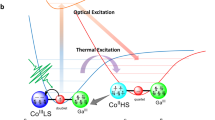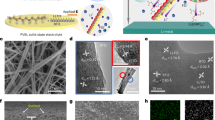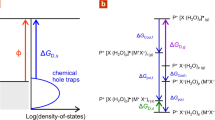Abstract
Ionic conductors serve as solid electrolytes for fuel cells and batteries, whereas polar crystals such as ferroelectrics and pyroelectrics—which are typically insulating materials—are used in electronic devices. Here we show a material that combines superionic conductivity with a polar crystal structure at room temperature. This three-dimensional anionic network is based on –Fe–N≡C–Mo– units, with Cs cations hosted in every other pore. In the resulting Cs1.1Fe0.95[Mo(CN)5(NO)]·4H2O material, the negative and positive charges of the framework and Cs+ ions, respectively, are non-symmetrically shifted in the c-axis direction of the unit cell, and spontaneous electric polarization is generated, in turn leading to second harmonic generation (SHG). Additionally, this material is a superionic conductor (with an ionic conductivity value of 4 × 10−3 S cm−1 at 318 K). Furthermore, the ionic conductivity significantly decreases under 532 nm light irradiation (from 1 × 10−3 S cm−1 to 6 × 10−5 S cm−1 at room temperature) and, when irradiation stops, returns to its original value within ~1 h.

This is a preview of subscription content, access via your institution
Access options
Access Nature and 54 other Nature Portfolio journals
Get Nature+, our best-value online-access subscription
$29.99 / 30 days
cancel any time
Subscribe to this journal
Receive 12 print issues and online access
$259.00 per year
only $21.58 per issue
Buy this article
- Purchase on Springer Link
- Instant access to full article PDF
Prices may be subject to local taxes which are calculated during checkout




Similar content being viewed by others
Data availability
X-ray crystallographic data have been deposited at the Cambridge Crystallographic Data Centre (http://www.ccdc.cam.ac.uk/) with reference no. 1907012. A copy of the data can be obtained free of charge via https://www.ccdc.cam.ac.uk/structures/. All other data supporting the findings of this study are available within the Article and its Supplementary Information. Data are also available from the corresponding author upon reasonable request.
References
Angell, C. A., Liu, C. & Sanchez, E. Rubbery solid electrolytes with dominant cationic transport and high ambient conductivity. Nature 362, 137–139 (1993).
Tiyapiboonchaiya, C. et al. The zwitterion effect in high-conductivity polyelectrolyte materials. Nat. Mater. 3, 29–32 (2004).
Gadjourova, Z., Andreev, Y. G., Tunstall, D. P. & Bruce, P. G. Ionic conductivity in crystalline polymer electrolytes. Nature 412, 520–523 (2001).
Makiura, R. et al. Size-controlled stabilization of the superionic phase to room temperature in polymer-coated AgI nanoparticles. Nat. Mater. 8, 476–480 (2009).
Kreuer, K. D., Paddison, S. J., Spohr, E. & Schuster, M. Transport in proton conductors for fuel-cell applications: simulations, elementary reactions, and phenomenology. Chem. Rev. 104, 4637–4678 (2004).
Croce, F., Appetecchi, G. B., Persi, L. & Scrosati, B. Nanocomposite polymer electrolytes for lithium batteries. Nature 394, 456–458 (1998).
MacFarlane, D. R., Huang, J. & Forsyth, M. Lithium-doped plastic crystal electrolytes exhibiting fast ion conduction for secondary batteries. Nature 402, 792–794 (1999).
Colomban, Ph Proton Conductors: Solids, Membranes and Gels—Materials and Devices (Cambridge Univ. Press, 1992).
Mcgeehin, P. & Hooper, A. Fast ion conduction materials. J. Mater. Sci. 12, 1–27 (1977).
Richards, W. D. et al. Design and synthesis of the superionic conductor Na10SnP2S12. Nat. Commun. 7, 11009 (2016).
Hayashi, A., Noi, K. & Tatsumisago, M. Superionic glass–ceramic electrolytes for room-temperature rechargeable sodium batteries. Nat. Commun. 3, 856 (2012).
Kreuer, K.-D., Paddison, S. J., Spohr, E. & Schuster, M. Transport in proton conductors for fuel-cell applications: simulations, elementary reaction, and phenomenology. Chem. Rev. 104, 4637–4678 (2004).
Yaghi, O. M. et al. Reticular synthesis and the design of new materials. Nature 423, 705–714 (2003).
Kitagawa, S., Kitaura, R. & Noro, S. Functional porous coordination polymers. Angew. Chem. Int. Ed. 43, 2334–2375 (2004).
Ohkoshi, S., Arai, K., Sato, Y. & Hashimoto, K. Humidity-induced magnetization and magnetic pole inversion in a cyano-bridged metal assembly. Nat. Mater. 3, 857–861 (2004).
Horike, S., Shimomura, S. & Kitagawa, S. Soft porous crystals. Nat. Chem. 1, 695–704 (2009).
Horcajada, P. et al. Porous metal–organic-framework nanoscale carriers as a potential platform for drug delivery and imaging. Nat. Mater. 9, 172–178 (2010).
Bogani, L. & Wernsdorfer, W. Molecular spintronics using single-molecule magnets. Nat. Mater. 7, 179–186 (2008).
Bureekaew, S. et al. One-dimensional imidazole aggregate in aluminium porous coordination polymers with high proton conductivity. Nat. Mater. 8, 831–836 (2009).
Yamada, T., Sadakiyo, M. & Kitagawa, H. High proton conductivity of one-dimensional ferrous oxalate dihydrate. J. Am. Chem. Soc. 131, 3144–3145 (2009).
Ohkoshi, S. et al. High proton conductivity in Prussian blue analogs and the interference effect by magnetic ordering. J. Am. Chem. Soc. 132, 6620–6621 (2010).
Furukawa, H., Cordova, K. E., O’Keeffe, M. & Yaghi, O. M. The chemistry and applications of metal–organic frameworks. Science 341, 974–986 (2013).
Coronado, E. & Espallargas, G. M. Dynamic magnetic MOFs. Chem. Soc. Rev. 42, 1525–1539 (2013).
Pardo, E. et al. High proton conduction in a chiral ferromagnetic metal–organic quartz-like framework. J. Am. Chem. Soc. 133, 15328–15331 (2011).
O̅kawa, H. et al. Proton-conductive magnetic metal–organic frameworks, {NR3(CH2COOH)} [Ma IIMb III(ox)3]: effect of carboxyl residue upon proton conduction. J. Am. Chem. Soc. 135, 2256–2262 (2013).
Yang, F. et al. A flexible metal–organic framework with a high density of sulfonic acid sites for proton conduction. Nat. Energy 2, 877–883 (2017).
Feynman, R. P. Slow electrons in a polar crystal. Phys. Rev. 97, 660–665 (1955).
Wang, H. et al. Thermally stable nonlinear optical activity in a smectic-A liquid crystal. Nature 384, 244–247 (1996).
Tayi, A. S. et al. Room-temperature ferroelectricity in supramolecular networks of charge-transfer complexes. Nature 488, 485–489 (2012).
Mandal, P. et al. Designing switchable polarization and magnetization at room temperature in an oxide. Nature 525, 363–366 (2015).
Pan, R. P., Wei, H. D. & Shen, Y. R. Optical second-harmonic generation from magnetized surfaces. Phys. Rev. B 39, 1229–1234 (1989).
Katz, H. E. et al. Polar orientation of dyes in robust multilayers by zirconium phosphate-phosphonate interlayers. Science 254, 1485–1487 (1991).
Chen, C. et al. Design and synthesis of an ultraviolet-transparent nonlinear optical crystal Sr2Be2B2O7. Nature 373, 322–324 (1995).
Berger, V. Nonlinear photonic crystals. Phys. Rev. Lett. 81, 4136–4139 (1998).
Fiebig, M., Lottermoser, Th, Fröhlich, D., Goltsev, A. V. & Pisarev, R. V. Observation of coupled magnetic and electric domains. Nature 419, 818–820 (2002).
Campagnola, P. J. & Loew, L. M. Second-harmonic imaging microscopy for visualizing biomolecular arrays in cells, tissues and organisms. Nat. Biotechnol. 21, 1356–1360 (2003).
Train, C., Nuida, T., Gheorghe, R., Gruselle, M. & Ohkoshi, S. Large magnetization-induced second harmonic generation in an enantiopure chiral magnet. J. Am. Chem. Soc. 131, 16838–16843 (2009).
Ohkoshi, S. et al. 90-degree optical switching of output second harmonic light in chiral photomagnet. Nat. Photon. 8, 65–71 (2014).
Chen, X., Nadiarynkh, O., Plotnikov, S. & Campagnola, P. J. Second harmonic generation microscopy for quantitative analysis of collagen fibrillar structure. Nat. Protoc. 7, 654–669 (2012).
Hsieh, C.-L., Pu, Y., Grange, R., Laporte, G. & Psaltis, D. Imaging with second-harmonic radiation probes in living tissue. Biomed. Opt. Express 2, 2532–2539 (2012).
Pantazis, P., Maloney, J., Wu, D. & Fraser, S. E. Second harmonic generating (SHG) nanoprobes for in vivo imaging. Proc. Natl Acad. Sci. USA 107, 14535–14540 (2010).
Nakayama, Y. et al. Tunable nanowire nonlinear optical probe. Nature 447, 1098–1102 (2007).
Hsieh, C.-L., Grange, R., Pu, Y. & Psaltis, D. Three-dimensional harmonic holographic microcopy using nanoparticles as probes for cell imaging. Opt. Express 17, 2880–2891 (2009).
Xuan, L. et al. Photostable second-harmonic generation from a single KTiOPO4 nanocrystal for nonlinear microscopy. Small 4, 1332–1336 (2008).
Delahaye, E. et al. Second harmonic generation from individual hybrid MnPS3-based nanoparticles investigated by nonlinear microscopy. Chem. Phys. Lett. 429, 533–537 (2006).
Bonacina, L. et al. Polar Fe(IO3)3 nanocrystals as local probes for nonlinear microscopy. Appl. Phys. B 87, 399–403 (2007).
Deyneko, D. V. et al. Ferroelectricity, ionic conductivity and structural paths for large cation migration in Ca10.5−xPbx(VO4)7 single crystals, x = 1.9, 3.5, 4.9. CrystEngComm 21, 1309–1319 (2019).
Renz, F. et al. Strong field iron(ii) complex converted by light into a long-lived high-spin state. Angew. Chem. Int. Ed. 39, 3699–3700 (2000).
Ohkoshi, S. et al. Cesium detection by terahertz light. Sci. Rep. 7, 8088 (2017).
Hauser, U., Oestreich, V. & Rohrweck, H. D. On optical dispersion in transparent molecular systems. Z. Phys. A 280, 17–25 (1977).
Coppens, P., Novozhilova, I. & Kovalevsky, A. Photoinduced linkage isomers of transition-metal nitrosyl compounds and related complexes. Chem. Rev. 102, 861–883 (2002).
Gütlich, P., Garcia, Y. & Woike, T. Photoswitchable coordination compounds. Coord. Chem. Rev. 219–221, 839–879 (2001).
Collet, E. et al. Laser-induced ferroelectric structural order in an organic charge-transfer crystal. Science 300, 612–615 (2003).
Margadonna, S., Prassides, K. & Fitch, A. N. Large lattice responses in a mixed-valence prussian blue analogue owing to electronic and spin transitions induced by X-ray irradiation. Angew. Chem. Int. Ed. 43, 6316–6319 (2004).
Polli, D. et al. Coherent orbital waves in the photo-induced insulator–metal dynamics of a magnetoresistive manganite. Nat. Mater. 6, 643–647 (2007).
Ohkoshi, S. et al. Synthesis of a metal oxide with a room-temperature photoreversible phase transition. Nat. Chem. 2, 539–545 (2010).
Irie, M., Fukaminato, T., Sasaki, T., Tamai, N. & Kawai, T. A digital fluorescent molecular photoswitch. Nature 420, 759–760 (2002).
Decurtins, S., Gütlich, P., Köhler, C. P., Spiering, H. & Hauser, A. Light-induced excited spin state trapping in a transition-metal complex: the hexa-1-propyltetrazole-iron(ii) tetrafluoroborate spin-crossover system. Chem. Phys. Lett. 105, 1–4 (1984).
Ohkoshi, S., Imoto, K., Tsunobuchi, Y., Takano, S. & Tokoro, H. Light-induced spin-crossover magnet. Nat. Chem. 3, 564–569 (2011).
Heintze, E. et al. Dynamic control of magnetic nanowires by light-induced domain-wall kickoffs. Nat. Mater. 12, 202–206 (2013).
Tokoro, H. et al. External stimulation-controllable heat-storage ceramics. Nat. Commun. 6, 7037 (2015).
Bertoni, R. et al. Elastically driven cooperative response of a molecular material impacted by a laser pulse. Nat. Mater. 15, 606–610 (2016).
Acknowledgements
The present research was supported partly by a JSPS Grant-in-Aid for Specially Promoted Research (grant 15H05697). We also recognize the Cryogenic Research Center, The University of Tokyo and the Center for Nano Lithography & Analysis, The University of Tokyo, which are supported by MEXT. We thank M. Komura, M. Numanyu and T. Chiba of Olympus Corporation for the SHG microscopy imaging.
Author information
Authors and Affiliations
Contributions
S.O. designed and coordinated this study, contributed to all measurements and analyses, and wrote the paper. K.N. conducted the conductivity measurements. K.I. conducted the 57Fe Mössbauer spectrum measurements and conductivity measurements. H.T. contributed to the setup of the conductivity measurements and IR measurement systems. Y.S. contributed to the sample characterization, SHG and THz-TDS measurements. K.O. contributed to the sample preparation and TG measurements. Y.M. contributed to the crystal structure analysis. M.K. contributed to the IR measurements. M.Y. contributed to SEM and optical microscopy imaging and partially wrote the paper. A.N. contributed to the analyses of crystal structure and IR spectra, and helped prepare the figures.
Corresponding author
Ethics declarations
Competing interests
The authors declare no competing interests.
Additional information
Publisher’s note Springer Nature remains neutral with regard to jurisdictional claims in published maps and institutional affiliations.
Supplementary information
Supplementary Information
Supplementary Video 1, SEM image and size distribution, crystal structure analysis, terahertz-time domain spectrum, magnetic properties, SHG measurements, photoswitching effect of ionic conductivity, and differential infrared spectra before and after light irradiation.
Crystallographic data
Crystallographic Information File for CsFeMo, CCDC 1907012
Crystallographic data
Structure factors for CsFeMo, CCDC 1907012
Supplementary Video 1
Polar crystal exhibiting a superionic conductivity and optical-switching effect
Rights and permissions
About this article
Cite this article
Ohkoshi, Si., Nakagawa, K., Imoto, K. et al. A photoswitchable polar crystal that exhibits superionic conduction. Nat. Chem. 12, 338–344 (2020). https://doi.org/10.1038/s41557-020-0427-2
Received:
Accepted:
Published:
Issue Date:
DOI: https://doi.org/10.1038/s41557-020-0427-2
This article is cited by
-
A BBO-like trithiocyanate with significantly enhanced birefringence and second-harmonic generation
Science China Materials (2023)



